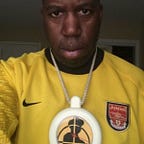Black Creativity and Exploitation: Race Music
If one word could be applied to this it would be FORESHADOWING. Foreshadowing when used in a fictional piece is a device that hints at something that will come later. Although we’re giving some historical information, what we’re really talking about is the thing called “Hip-Hop.”
We loosely defined Hip-Hop as the creative expression of Black people here in North America and we’ve taken a trip back in time to illustrate how that expression has been codified, monetized, and exploited.
First, we took you to the beginning of the Music Industry which began with the selling of sheet music that eventually morphed into the record industry. We illustrated how difficult it was for Black folk to enter said fields and how they had to part ways with their creation, giving up all licensing and control if they wanted that music published or recorded.
The first homegrown genre that gained popularity in America as well as Europe, we discussed, was called Ragtime, a syncopated, piano-based music that originated with Black people, played in places of ill-repute, but that eventually became mainstream spawning a sub-genre, “Coon Music.” This brought us up to the first recordings of Black people. The year was 1920.
Cut to 1977. Emcees have been rapping over music constructed by Disc Jockeys that produce extended mixes by playing the same song on two turntables, switching between the two, only allowing five to ten seconds of the record to be heard. No one saw the value in this until a recording was made that sold a ton of records. Nonetheless, between 1979 and 1981 Rap music was solely recorded and owned by Black labels. Mercury Records was the only major label that saw value in the genre and signed Kurtis Blow, but by and large, white people didn’t want anything to do with Rap.
We’ll return to that. Back to 1920. The campaign to get white labels to record Black people has been going on for years. Years. When finally someone bites, thanks to the undying efforts of singer/songwriter Perry Bradford. Bradford was a musician of his times, he wrote music, he sang, he danced, he traveled with minstrel shows, and he was a salesman.
Bradford had some tunes , “Crazy Blues,” in particular, a song that he wrote in 1918. Mamie Smith was a part of a Bradford production and was the voice of said song. It just needed to be recorded. And that was his proposal to independent label Okeh Records coupled with a sales pitch of how many Black people would be clamoring to buy the record. Eventually, recording director Fred Hager relented and agreed to a single deal.
That initial recording, “That Thing Called Love” b/w “You Can’t Keep a Good Man Down” sold well enough for Okeh to be okay with Bradford and Smith recording another tune. The tune was “Crazy Blues,” and it was a hit — 75,000 records sold in a month hit — a rethinking the approach to Black people hit- an inspiring others hit.
This is how songwriter Noble Sissle remembered the release of the song:
“I was in Baltimore; it was wintertime. And this record just came out. And a fella in a cigar store put a phonograph [in the doorway] and pointed the record out the door, so people could hear it. . . . …and people run right over and said, ‘Give me that.’ Because they’d been waiting for that sound so long.”
The success of “Crazy Blue” spawned what Okeh dubbed Race Records, a catch-all name that encompassed Black music of every genre: Blues, Jazz, Comedy, gospel, whatever.
This was seen as an opportunity by Black people as well. One man was aligned and qualified to seize it — his name was Harry Pace.
If you could count the ways that a Black person could be successful in the early 1900s, Pace was a part of it. He graduated from Atlanta University and was mentored by W.E.B DuBois, he worked in banking, insurance, printing, and sheet music publishing. Pace was no lightweight.
The popularity of “Crazy Blue” made Pace pivot out of the sheet music world and into recording. He labeled his venture Black Swan records and for the next two years he laid the groundwork for how to market to and advertise Black records.
Pace took out ads in Black newspapers emphasizing that the artists on the label were Black and of the best quality. For distribution, Pace focused on Black record stores. And he was successful. When Sugar Hill Records released “Rapper’s Delight,” it was the same model that they followed. Like we said, foreshadowing. But let’s stay in the 20s.
Black Swan would go on to issue 180 records, sell countless amounts but they were still under-capitalized and when white labels wanted in on all that Black money, they simply followed Pace’s example. That spelled trouble.
Early on, Pace had agreed to get his records pressed with the Wisconsin Chair Company, owners of Paramount Records. Black Swan would give Wisconsin a copy of their masters in exchange for printing their albums. Eventually, Pace was able to buy his own pressing facilities but it wasn’t enough. He couldn’t keep up with demand.
Guess who took over for Pace? That’s right, Paramount Records. Initially, Pace still owned his masters but with no way to record or distribute, those masters became the property of Paramount.
And this is paramount (no pun intended).
The Honorable Elijah Muhammad teaches us that the original man is the maker AND the owner. But what happens when the maker no longer owns?
What happened over the next twenty years is akin to what happened in the 80s and then again in the late 90s/early 2000s. White labels saw the value of Black creations, competed with them using the same techniques they employed, outspent the Black owners, and eventually took them over. This wouldn’t be the last time something like this happened.
